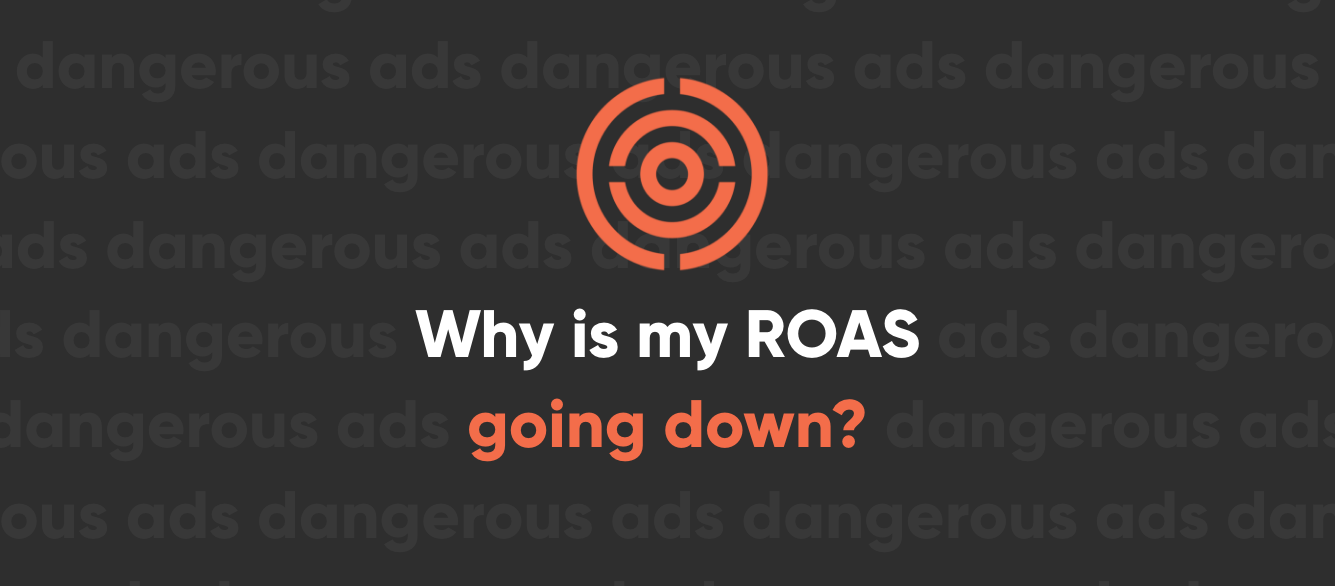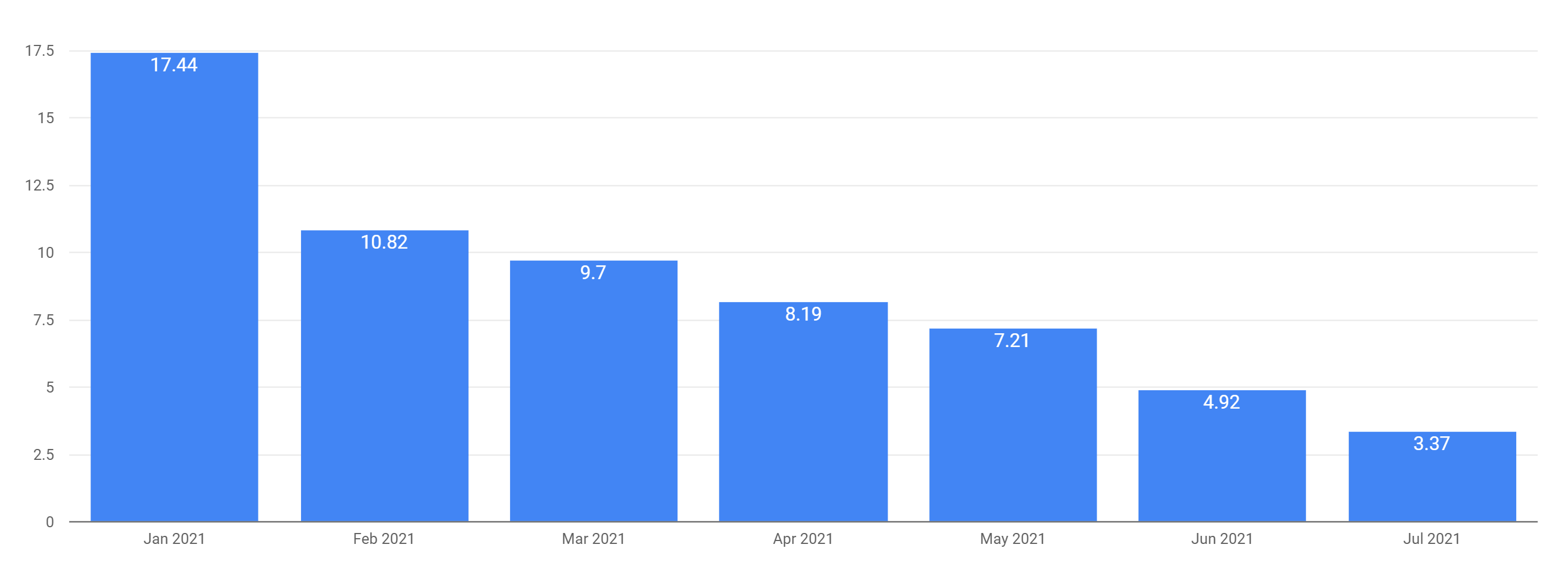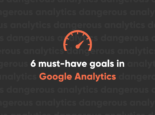
Why Is My Return On Ad Spend (ROAS) Going Down?

Digital advertising is an essential part of almost any marketing strategy. Of course, in order for digital advertising to be a viable channel, you need to see a positive return on your ad spend.
Unfortunately, in today’s highly competitive and rapidly changing markets, many companies are seeing their return on ad spend go down.
In this post, I’ll discuss the four primary reasons behind this decline and present some ideas for how you can overcome these issues.
What is Return on Ad Spend?
Return on ad spend, more commonly referred to as ROAS, is one of the key metrics for measuring the success of your ad campaigns, especially for e-commerce. We’ve already written in-depth about what ROAS means, but here is the really simple version:
Return on ad spend is the ratio of revenue from ads to how much you spent on those ads.
In other words, ROAS tells you how many dollars you get back for every dollar you spend.
Read more about ROAS and test our return on ad spend calculator
What’s a Good Return on Ad Spend?
Whenever we prepare to launch a digital advertising campaign for a client, we always discuss target ROAS. Inevitably, when we ask a client what their target ROAS is, they reply with something like this:
“Well, what’s a good ROAS?”
And our typical response is the easy and non-committal answer: it depends.
A good ROAS depends on a lot of factors such as your business goals, your campaign goals, your lifetime customer value, your profit margins, and more. The most important factor is typically your profit margin (both overall and per product). If your profit margin is 10%, you obviously need a much higher ROAS than if your margins are 95%.
Generally speaking though, you should shoot for at least a 3:1 ROAS on any direct e-commerce campaigns. Just make sure you adjust this number accordingly based on your business model. After all, you don’t want to lose money on your advertising efforts.
One big caveat here: If you have a subscription-based e-commerce model, then you should focus on customer acquisition cost instead of ROAS. You might be willing to lose money on your first sale because you know the lifetime value (LTV) is going to make the ad spend very profitable in the long run.
Ultimately, you need to use ROAS when it makes sense for your business. ROAS typically shouldn’t be used to measure brand awareness campaigns, lead generation campaigns, webinar signups, e-book downloads, or other campaigns that don’t drive immediate and easy-to-measure revenue.
The Four Main Reasons Behind Declining ROAS
If you’ve seen a dip in your ROAS during the past few months, you aren’t alone. Almost every business that has been running digital advertising campaigns for any significant length of time is experiencing this. Here’s why:
1. Increased Competition
After a flat 2020, digital advertising spend is at an all-time high across pretty much every industry—especially e-commerce. Unfortunately, the size of your audience and the demand for your products and services likely hasn’t grown significantly. It might actually be going down (more on that in a bit).
Additionally, many e-commerce spaces have become more crowded as many businesses have invested more into e-commerce offerings. Add all this together, and you have a lot more businesses spending a lot more money to target the same audience. Something has to give here, and it’s usually going to be your ROAS.
All of this has resulted in higher costs per click (CPC), higher costs per thousand impressions (CPM), and higher costs per transaction.
The key to keeping your ROAS up in the face of increased competition is to stand out and make sure you are targeting the right customers. This means more than differentiating yourself by leaning into your unique value proposition (you do have one, right?). You also need creative that catches the attention of your unique audience. If you miss out on these things, then your ads will get lost among the wall of sameness delivered by your competitors.
It’s extra important with these rising costs to make sure you are targeting the right audiences. If the data is telling you that 45–54-year-old men from New York on desktop devices convert at the highest rate, then double down on that audience rather than trying to grow your market share of teenagers in Duluth on mobile devices that never buy your products.
2. The Post-COVID Impact
No, COVID isn't over yet, but we are starting to see the impacts of a post-COVID world. As alluded to above, many e-commerce industries are seeing shrinking demand as more people go back to physical stores to buy more goods. No, that doesn’t mean e-commerce is dying. It never will. But e-commerce had massive increases last year when people were forced to buy pretty much everything online. Now we are starting to see some return to normal shopping habits. Also, many businesses weren’t investing as much on digital ads last year because they had budget cuts or spending freezes.
As a result, the e-commerce brands that were investing in digital advertising often saw big increases in their ROAS numbers. This has set false expectations for 2021. If you are comparing your 2020 Q2 ROAS to your 2021 Q2 ROAS, then you most likely aren’t comparing apples to apples. It’s more like a grapes-to-raisins comparison at this point. Yes, they are technically the same at their core, but one was plump and ripe while the other has been shriveled from being out in the sun too long.
If you’re in this situation and wondering why your year-over-year ROAS has taken a deep dive, take a look back at the previous year for a better comparison. And remember that a declining ROAS doesn’t mean your campaigns aren’t successful. Go back to your target ROAS and remind yourself of what you need to accomplish to be a profitable and growing company.
3. Changes in Attribution
Return on ad spend is highly dependent on the attribution model you’re using. Since ROAS is a direct measurement of the revenue driven by ads versus your ad spend, you need to make sure you are correctly attributing sales to your ad efforts.
Unfortunately, we’ve seen some significant changes in attribution this year, most notably from Facebook. In early 2021, Facebook removed its 28-day attribution window, which is what many advertisers used as their standard measurement. Under this old model, anyone who saw your ad and made a purchase within 28 days counted toward your ROAS numbers. The new max attribution window is just 7 days.
As you can probably guess, a longer attribution window gives people a lot more time to buy your products and still have your ads take the credit. Since purchase decisions often aren’t instantaneous, this change in attribution is likely impacting your ROAS.
As we discussed with point two above, if you’re comparing your current ROAS to a previous time period that had a different attribution window, you are setting yourself up for failure. Unfortunately, there is no easy way to go back and recalculate your previous ROAS based on a different attribution period, so this one takes a bit of guesswork to figure out. It’s certainly not as simple as dividing by four to make up for a window that’s only a fourth as long.
Once again, instead of focusing on comparisons, you need to focus on the minimum ROAS that’s profitable for you. Additionally, you also need to consider the incremental lift that Facebook (or other display ads) is providing for your business. Even if your Facebook ads are falling short of your ROAS goal, that doesn’t mean they aren’t profitable for your business on the whole. In many cases, Facebook ads are driving revenue that can’t be directly attributed because they lead to increased search volume and raised awareness of your brand and products. Facebook usually doesn’t get credit for those purchases.
These less tangible impacts on revenue require a much more thorough analysis of your data in order to determine the true impact of your ads.
4. Privacy Changes
Last and certainly not least, there have been significant changes in privacy that have had a major impact on digital advertising. Most notably, Apple’s App Tracking Transparency (ATT) and a shift toward a cookieless world have wreaked havoc on an advertiser’s ability to always target the right person at the right time.
As a result of these changes, targeting on Apple devices has become much more difficult. We’ve also seen a lot more spend shifted to Android devices, making it increasingly difficult to find ways to minimize your spend while maximizing your reach. All of this combined has led to lower ROAS across just about every platform and every device.
Since these privacy issues aren’t going away any time soon (in fact, they are going to get much worse), a good digital advertiser has to be hyper-aware of how to fine-tune targeting and quickly cut out non-converting spend. This doesn’t mean you can’t target that 52-year-old man on his desktop in New York. It’s just a little harder now.
Other Reasons Your ROAS Is Going Down
Of course, not every change to ROAS is due to industry trends or market changes. Sometimes it's directly related to your business or your advertising tactics. Here are some other reasons we commonly see that explain a declining return on ad spend:
- Inventory issues and out of stock products
- Poor targeting (either audience or keyword)
- Poor bid management
- Slow website speed
- Other website issues that impact conversion rate
- Seasonality
In order to determine what's causing your decreasing ROAS, you need to have an expert look under the hood and fully analyze your advertising campaigns at every touchpoint.
For example, here's one company that recently saw big drops in ROAS that weren't related to any industry trends or changes in the market:

This is clearly a pretty extreme example of something going seriously wrong. After achieving an outstanding 17:1 ROAS in January, the company saw a steady decline for the next six months. Now, their ROAS is just over 3:1. That's a massive drop that should cause anyone concern.
In this case above, we had been managing the advertising campaigns for the client. In February, they decided to handle those campaigns on their own. As you can see, the results were far from favorable. The two biggest reasons for the decline in ROAS here were:
- Poor spending practices
- Not actively managing their audiences, keyword targeting, and bids
As a result, this company has seen the profitability of their advertising campaigns plummet. This is a great example of why advertising is not set-it-and-forget-it!
Final Thoughts on Declining ROAS
Yes, your ROAS is probably down right now. But that doesn’t mean you should stop spending. It simply means you need to be more aware of your minimum ROAS targets and much more cognizant about how you are spending your money on ads.
Hiring the right digital marketing agency is one of the best ways to fight declining ROAS. If you’ve been handling ads in-house, it might be time to outsource those efforts to an agency that has more resources and larger benchmark databases to drive better results.
At Perrill, we’ve consistently delivered return on ad spend well above industry benchmarks for our e-commerce clients. Yes, we’ve seen some decreases in our own efforts based on all the factors above, but we’ve also figured out how to navigate these difficult waters and continue to drive positive results for our clients.
If you are struggling to achieve the right ROAS, contact Perrill today to start getting the results you need.

Nate Tower
Nate Tower is the President of Perrill and has over 12 years of marketing and sales experience. During his career in digital marketing, Nate has demonstrated exceptional skills in strategic planning, creative ideation and execution. Nate's academic background includes a B.A. with a double major in English Language and Literature, Secondary Education, and a minor in Creative Writing from Washington University. He further expanded his expertise by completing the MBA Essentials program at Carlson Executive Education, University of Minnesota.
Nate holds multiple certifications from HubSpot and Google including Sales Hub Enterprise Implementation, Google Analytics for Power Users and Google Analytics 4. His unique blend of creative and analytical skills positions him as a leader in both the marketing and creative worlds. This, coupled with his passion for learning and educating, lends him the ability to make the complex accessible and the perplexing clear.
Author
Nate Tower
Date
Explore with AI
Join Our Newsletter


Why Google Shouldn’t Reveal Its Search Algorithm


8 Signs You Need a Website Redesign


